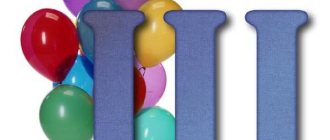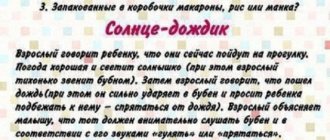July 16, 2018
Averyanova Sveta
Pronouncing the hard and soft sound “r” is rarely easy for children. In speech therapy, there is even a special “indulgence” for “l” and “r”: if for the basic alphabet the norm of development is within 4 years, then for “l” and “r” experts allocate two more preschool years - up to 6 years .
When preparing for school, teachers especially focus the attention of parents on how to teach their child to say the letter “R”. In school education, incorrect pronunciation can become a problem for a child, first of all psychological, and then communicative. A careful attitude to children's speech at 2-4 years old can correct the situation.
Difficulties with pronunciation: why does the child not pronounce “R”
In speech development, the sound “r” is considered one of the most difficult to pronounce, so speech therapists devote a large period of time to studying it. So, a two-year-old child cannot yet speak the letter P clearly and clearly. But by the age of 5-6 years, the time has come for productive results in sound pronunciation.
In what case is the pronunciation of R considered incorrect:
- When voicing the word “r” drops out of pronunciation (caravan - “ka_avan”);
- In words with the letter “r” the child changes/swallows the ending;
- In his speech, the child replaces the “r” in words with simpler sounds “y”, “l” or “th” (rainbow - “laduga”, tree - “deyevo”, etc.);
- The child pronounces the sound “r” with vibration or gutturally, in the French manner.
Note! Incorrect pronunciation is acceptable as the child’s articular apparatus prepares to master speech sounds.
But when 1.5-2 years of training do not lead to improved speech, there is reason to be wary. Video assistant: learning to say the sound “R” beautifully:
Body factors influencing difficulty in pronunciation R
The difficulty of pronouncing the sound “r” can be due to many reasons, including physiological ones, which cannot be ignored.
- Short frenulum of the tongue
An undeveloped frenulum can impede the development of speech, including interfering with the correct pronunciation of sounds. The child simply cannot reach the upper palate with his tongue and produce a sound. The degree of underdevelopment of the frenulum is determined by a speech therapist, who also makes a decision on the need for its correction.
On a note! The frenulum can be developed with the help of speech gymnastics exercises; in extreme cases, surgical intervention is used.
- Sedentary speech apparatus
Poor mobility of the face and speech organs may be the cause of poor speech quality in a child. Its training is necessary to strengthen the facial muscles. Active movements of the mouth (wide smile, tube lips, etc.), grimaces help prepare the articular apparatus for the correct pronunciation of sounds. The better the speech organs are developed, the clearer the baby’s speech will be.
- Incorrect phonemic awareness
With this violation, the child incorrectly interprets the word he hears (dudka - “tutka”, pajamas - “bizyama”, etc.). Incorrectly pronounced sounds may seem funny to adults, but by repeating them over and over again, the child runs the risk of distorting them with increasing regularity.
- Impaired breathing
If air leaks in the wrong direction during breathing, sounds may not be pronounced correctly by the child. This is especially noticeable in preschoolers when R is pronounced “on the nose.” The cause (in addition to nasal congestion from a runny nose) may be enlarged adenoids, poor lung function, or problems with the cardiovascular system. In this case, speech breathing is corrected under the supervision of a doctor using exercises alternating physical and speech stress.
Levina's method
Speech therapist R. E. Levina in 1965 developed a set of articulation exercises for teaching the pronunciation of “R”.
At the first stage, the exercises are aimed at obtaining the fricative "P" without vibration after achieving correct articulation.
On the second stage, the vibration of the tongue from the sounds “Ш”, “Ф” is trained. The child parts his lips without rounding them, extends the “F”, moves the tip of his tongue upward to the gums, there is no gap between them. The child exhales forcefully.
To generate vibration, use the sound “D”, which is pronounced in one exhalation. The mouth is wide open, the front edge of the tongue is tightly connected to the gums of the upper teeth. “D” is pronounced instead of “R” in words with the combination “TR” or “DR”.
Do you need help from a speech therapist?
Teaching your child to pronounce the sound R correctly on your own is quite possible. But an initial consultation with a speech therapist will not be superfluous. A specialist will help you correctly determine the cause of pronunciation difficulties, and will also offer optimal options for forming clear and intelligible speech.
How a speech therapist can help a child:
- determine the specific cause of the child’s speech impairment;
- will study the symptoms and structure of speech disorders;
- will create an individual system of corrective influence on the speech apparatus.
The first visit to a speech therapist usually occurs at the age of 2-3 years; it is included in the routine examination before going to kindergarten. Almost always, in conjunction with a consultation with a speech therapist, the child is examined by a neurologist to rule out disorders in brain development (dysarthria, dyslalia, bradyllalia, etc.).
Bogomolova method
A.I. Bogomolova in 1979 proposed a method for generating vibration for saying “R”. The teeth are open to a distance of 2 fingers. The tongue is pressed against the palate, stretching the frenulum as much as possible. The teacher moves the edges of the tongue towards the palate with his fingers, while the frenulum is free.
The child takes a deep breath and blows it out sharply, using his voice. The combination “TZ” is formed. Repeat the exercise, gradually increasing the air pressure. The sound combination “TLE” will change to “TR”. After fixing the short “TR”, they practice the rolling “TR” with the help of fingers, and then without them.
Learning to say “R”: speech gymnastics
Many parents are wondering how to quickly teach their child to say the letter R. At home, the speech apparatus can be developed using simple exercises. At the initial stage of work, speech gymnastics is used. It is this, together with the step-by-step production of sounds, that will make the baby’s speech clearer.
Speech gymnastics is divided into three groups, each of which is important for the formation of correct sound pronunciation. Here are a few examples of each type of gymnastics that can be used if you have difficulty pronouncing the letter “R”.
Breathing exercises
"Birthday" . Try to imagine that in front of you is a birthday cake with candles. Show your parents how you will blow out the candles. Take in some air to blow it all out at once. And then try to blow out one of them.
“Flight of a snowflake” . Place a piece of fluffy cotton wool on your palm and imagine that it is a snowflake. Try to blow it off your hand. It turns out? Try to blow away two pieces at the same time. Inhalation should be through the nose, and exhalation should be smooth and long through the mouth.
Lip exercises
“Fence” . Grind your teeth tightly. Now open your lips (not your mouth!) and show your white little fence. Hide it back. Repeat the exercise 5-7 times.
“Proboscis” . Try to show what kind of proboscis an elephant has. To do this, stretch your lips forward as much as possible. What a proboscis!
"Frog" . Stretch your lips in a smile, show how wide the frog’s mouth is.
Tongue exercises
“Needle” . The sharp needle can be shown with your tongue. Open your mouth and stretch your narrow tongue forward.
“Horse” . Try to show how a horse clicks. Open your mouth, lift and press your tongue to the roof of your mouth, click it.
"Jam" . Imagine that you have sweet jam on your lips. Open your mouth, try to lick your upper and lower lips with your tongue.
"Swing" . Open your mouth, make a sharp tongue. First stretch your tongue high to your nose, then lower it low to your chin. Repeat the exercise in the same sequence: up/down until the tongue gets tired.
We do “Drummer” and other useful exercises, as shown in the video:
What is considered normal?
The trembling consonants “r” (hard) and “ry” (soft) are correctly pronounced in a certain way. If a child speaks the letter r normally, then he has:
- Half-opened lips or open in such a way that the next sound (mostly a vowel) can be pronounced.
- The tip of the tongue rests against the alveoli behind the upper teeth.
- Air passes calmly between the palate and the back of the tongue.
- Loose teeth.
- The lateral edges of the tongue are tightly adjacent to the upper molars.
- Vibration of the vocal cords occurs.
- Tongue vibration is achieved due to the air flow during exhalation.
If you lift the middle part of the back of the tongue towards the palate and move the tongue forward a little, a soft “r” will be born.
Exercises to stretch the frenulum of the tongue
With a short frenulum of the tongue, speech therapists first of all recommend stretching it with the help of massage and articulation exercises. They can be performed in a playful way, and with the proper approach, the frenulum will no longer be an obstacle to the pronunciation of the sound “r”. It should be noted that the conservative method of frenulum lengthening is effective in children under 5 years of age.
- Reaching up to the nose
Reaching the tip of the nose is not a task that everyone can do, but you can hold a competition to see who can reach the strongest. The tip of the tongue should be pulled up as much as possible. Repeat the exercise 5-7 times a day.
- Like a kitten
Has your child ever seen kittens lap up milk? Invite your child to try lapping something like a house cat. For example, condensed milk on a plate. This is an excellent action for stretching the frenulum.
- Light massage
Massage of the hyoid frenulum to stretch it is carried out by adults. This simple procedure can be carried out at home after the method of stretching the frenulum with massage is demonstrated by a speech therapist. The child opens his mouth and lifts the tip of his tongue upward. With clean fingers (thumb and forefinger), the adult carefully takes the frenulum under the tongue and makes massaging movements. A slight upward pull of the bridle is acceptable. Do the massage 2 times a day for 3 minutes.
Preparation of the articulatory apparatus
In correctional classes, the preparatory stage is devoted to working with the articulatory apparatus. Exercises are performed to stretch the hyoid ligament, lift the tongue upward, and warm up the lips and jaw.
Tasks for preparing the articulatory apparatus for work:
- “Swing” - open your mouth, stretch your tongue alternately to your nose and chin.
- “Horse” - click your tongue slowly and forcefully, imitating the sound of a horse’s hooves, while the lower jaw remains motionless.
- “Chatter” - use the wide tip of your tongue to run back and forth along your upper lip, without lifting your tongue. Simultaneously say “BL-BL-BL”.
Teaching your child to say the sound “R” at home – what to take note
Exercises for practicing with a child are very simple, but, nevertheless, at first they can cause difficulties. If you decide to practice on your own, be patient and persistent in the process of mastering the pronunciation of the letter R. Remember - even small but regular speech training can bring results.
Here are some useful tips for the process of learning sound pronunciation:
- In order not to lose your child’s interest in the exercises, practice several sounds sequentially. Move from simple tasks to more complex ones, sequentially. If your child finds one of the tasks difficult over and over again, offer an alternative;
- use a variety of material to automate and reinforce sound in speech. Alternate in your classes pure sayings, poems, pictures with objects, sets of words that contain the sound being practiced;
- For a progressive result, a positive emotional mood in the child is important. If the baby is not in the mood to exercise for some reason, then do the exercises a little later;
- delivered sounds require constant reinforcement in speech. Therefore, systematicity in conducting classes is important. Dedicate time to “problem” sound for at least 20 minutes daily.
PS We also advise you to read other useful materials from the “Children’s Education and Development” section
How to record soft and hard sounds
In transcription, soft consonants are indicated by adding the sign '. This sign is called an apostrophe. For example, the hard sound [p] remains this way, but the soft sound will look like this [p'].
It is not difficult. Once you are done explaining the theory, you can start practicing. Have your child complete a simple task. For example, write down a few words and ask your son or daughter to choose only those with soft sounds. And then let him make a transcription with an apostrophe. Do several of these exercises with your child, and he will definitely remember how a soft consonant is indicated and how to find it in words.










